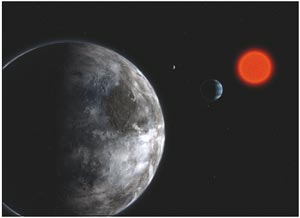A rocky planet only five times the mass of the Earth was discovered around the nearby low-mass star Gliese 581. This is the most Earth-like planet known to date and furthermore its orbit is at the “warm” edge of the habitable zone around that star, thus allowing speculation that this planet could harbour life.

Image credit: ESO.
The quest for detecting new planets orbiting other stars than the Sun is boosted by the huge impact that this research field has on the general public (CERN Courier October 2004 p19). During one week, the Observatory of the University of Geneva was overwhelmed with phone calls from all over the world concerning the discovery and its implications for life in the universe. This mass interest was beyond the expectations of the discovery team led by Stéphane Udry, which simply published its findings in a specialized, rather than an interdisciplinary, scientific journal.
The faint star Gliese 581 is only 20 light-years away and is thus among the 100 closest stars. It is one of some 100 ”M dwarf” stars monitored by the High Accuracy Radial-velocity Planet Searcher (HARPS) mounted on the 3.6 m telescope of the European Southern Observatory (ESO) at La Silla, Chile. This high-precision spectrometer previously found a Neptune-mass planet around Gliese 581, but with more observations and refined analysis the astronomers discovered two additional planets by detecting the wobbling that their gravitational pull exerts on the star. The two new planets have masses of five and eight times the mass of the Earth and orbit the red dwarf star every 13 and 84 days, respectively. Although these planets are much closer to Gliese 581 than the Earth is to the Sun, they are located approximately at the warm and cold edges of the habitable zone of such a low-luminosity star. Among the more than 200 extra-solar planets detected so far, some others have been found to be in the habitable zone of their parent star, but they were all bigger gaseous planets.
Apart from very exotic low-mass planets orbiting pulsars, the new planet of only five times the mass of the Earth is the lightest extra-solar planet found to date. With a diameter estimated to exceed that of the Earth by only 50% and being in or just at the boundary of the habitable zone makes it the prime subject of interest. According to Udry, the surface temperature of the planet depends on the highly uncertain composition and thickness of its atmosphere. Nevertheless, an equilibrium temperature between –3° C and +40° C was estimated for a Venus-like and an Earth-like albedo, respectively. It is therefore likely that water could be liquid on the surface of this planet, although the strength of the greenhouse effect remains an important unknown.
The existence of liquid water and the possibility of life on this planet cannot be probed directly at the moment and we can only consider it as the best known candidate for future space-mission projects, like NASA’s Terrestrial Planet Finder and ESA’s Darwin, to search for the signature of water and oxygen in its atmosphere. However, the relatively old and quiet star Gliese 581 has already became one of the most famous stars in the universe and currently focuses all hopes to find a nearby Earth twin.







